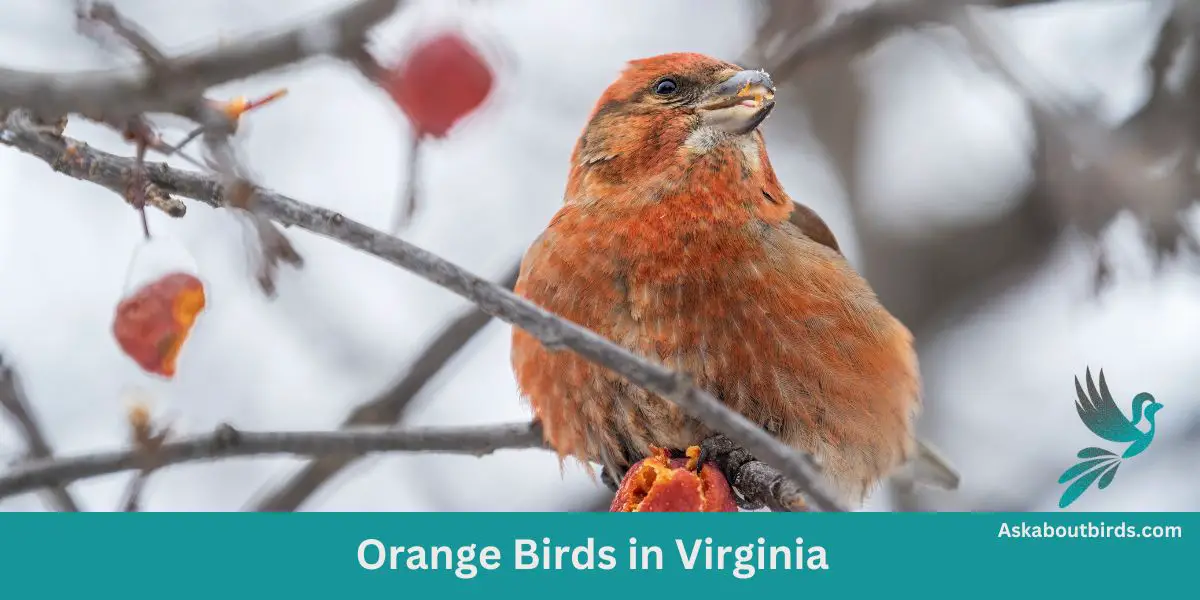Virginia, often dubbed the “Old Dominion,” boasts a varied landscape of coastal plains, rolling hills, and majestic Blue Ridge Mountains, is a haven for bird enthusiasts. Among the myriad of feathered beauties, the state is graced by distinctive orange-hued species that add a splash of color to its avian tapestry.
Orange Birds Found In Virginia
Virginia’s geographical diversity, combined with its position along the Atlantic Flyway, creates a unique haven for bird species. Its coastal wetlands attract waterfowl and shorebirds, while the dense forests of the western regions are home to numerous songbirds and raptors.
Baltimore Oriole


| Feature | Measurement |
|---|---|
| Scientific Name | Icterus galbula |
| Length | 6.7–8.7 in |
| Wingspan | 9.1–12.6 in |
| Weight | 22.3-42 g |
The Baltimore Oriole is a stunning bird, best known for its vibrant coloration and its rich, whistling song.
Appearance: The male Baltimore Oriole is notable for his bright orange and black plumage and black and white wing bars, a stark contrast to the more muted yellow-brown coloration of the female. Both sexes, however, have long pointed bills and white bars on their wings.
Diet: Baltimore Orioles have a diverse diet that includes insects, fruits, and nectar. Their preference for sweet juices and fruit pulp often brings them to backyard feeders offering oranges and jelly.
Reproduction: The female Baltimore Oriole is responsible for building the distinctive hanging nest, often woven together from fine materials like hair and grass. These nests are usually high in trees to avoid predators. The female lays 3-7 eggs, which are incubated for about two weeks.
Red-breasted Nuthatch

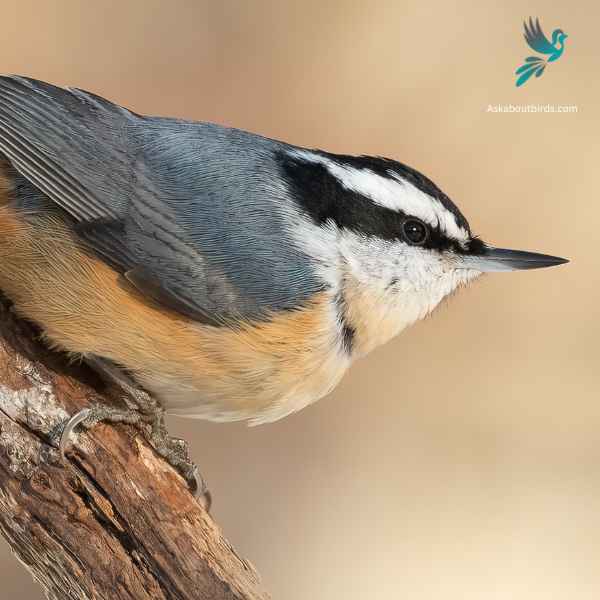
| Feature | Measurement |
|---|---|
| Scientific Name | Sitta canadensis |
| Length | 4.3–4.7 in |
| Wingspan | 8.3 in |
| Weight | 0.3–0.5 oz |
The Red-breasted Nuthatch is a small, agile songbird, known for its ability to move headfirst down tree trunks while searching for food.
Appearance: This bird boasts a slate-blue back and a pale rust-red underside. A prominent black stripe runs through the eye and is bordered above by a white eyebrow. Their sharp, pointed bill is characteristic of the species.
Diet: Red-breasted Nuthatches primarily feed on insects and seeds, especially those from coniferous trees. They have a fondness for large seeds, which they wedge into bark crevices to hack open with their bills.
Reproduction: These birds construct nests in natural tree cavities or abandoned woodpecker holes, often lining the entrance with resin. This is thought to deter predators or competitors from entering. The female typically lays a clutch of 5 to 6 eggs, and both parents partake in feeding the chicks once they hatch.
Barn Swallow

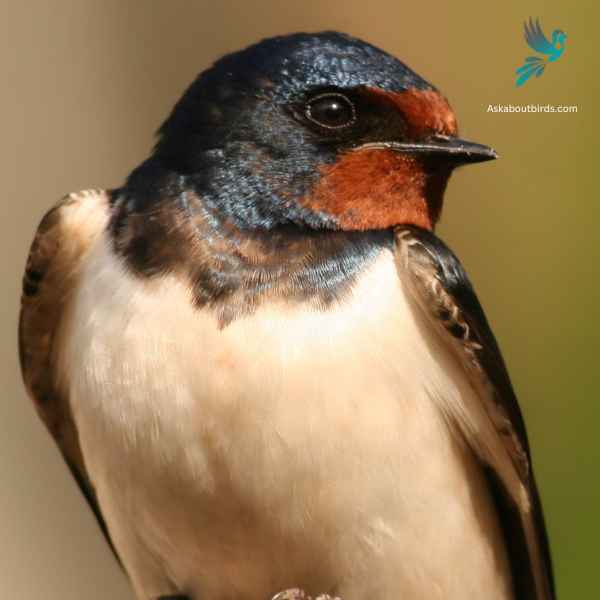
| Feature | Measurement |
|---|---|
| Scientific Name | Hirundo rustica |
| Length | 6.5–7.5 in |
| Wingspan | 12.5–13.5 in |
| Weight | 16–22 g |
The Barn Swallow is a sleek, agile bird renowned for its graceful flight patterns and iconic forked tail, often seen darting over fields and water bodies in search of flying insects.
Appearance: Barn Swallows have deep blue, almost iridescent, upperparts and a rufous to tawny underbelly. Their distinctively forked tail and long wings give them a streamlined look. Both males and females have a similar appearance, though males often exhibit slightly brighter colors and a deeper fork in the tail.
Diet: Barn Swallows feed primarily on flying insects, which they catch in mid-air during their agile and acrobatic flights. Their diet includes flies, beetles, moths, and other small flying insects.
Reproduction: Barn Swallows are known for building their mud nests on man-made structures, particularly barns, bridges, and eaves. The nest is cup-shaped and made from mud pellets, often lined with feathers. The female lays a clutch of 4 to 6 eggs.
American Robins


| Feature | Measurement |
|---|---|
| Scientific Name | Leptotila plumbeicep |
| Length | 10.6-11.8 in |
| Wingspan | — |
| Weight | 160-200 g |
The American Robin is a widely recognized bird species known for its melodious song and early bird tendencies.
Appearance: American Robins are medium-sized birds with a distinctive appearance. Both males and females sport a gray to brown back and a warm red to orange breast and belly and gray wings. They also have a characteristic white eye-ring and a black head, but males are usually darker than females.
Diet: American Robins have a diverse diet that changes depending on the season. In summer, they feed heavily on earthworms, beetles, and other invertebrates, which they catch on the ground. During winter, they mostly eat fruits and berries.
Reproduction: American Robins usually build their nests in trees or shrubs, but they are also known to nest on human-made structures. The female lays a clutch of about 3 to 5 eggs, which she incubates for about 12 to 14 days.
American Redstart


| Feature | Measurement |
|---|---|
| Scientific Name | Setophaga ruticilla |
| Length | 4.3 to 5.5 in |
| Wingspan | 6.3 to 9.1 in |
| Weight | 8.6 g |
The American Redstart is a lively warbler known for its vivid colors and active hunting style, often seen flitting about, fanning its tail to startle and catch insects.
Appearance: Adult male American Redstarts boast striking black plumage with bright orange patches on the sides, wings, and tail. Females and immature males have grayish-olive upperparts with yellow patches in the same areas where the males display orange.
Diet: American Redstarts are primarily insectivores. They actively forage for flying insects, as well as caterpillars and spiders, often using their colorful tails to startle prey and make them easier to catch.
Reproduction: The female American Redstart builds a cup-shaped nest in the fork of a tree branch. Typically, she lays a clutch of 3 to 5 eggs. The female takes on the primary responsibility of incubating the eggs, while both parents participate in feeding the fledglings after they hatch.
Eastern Towhee

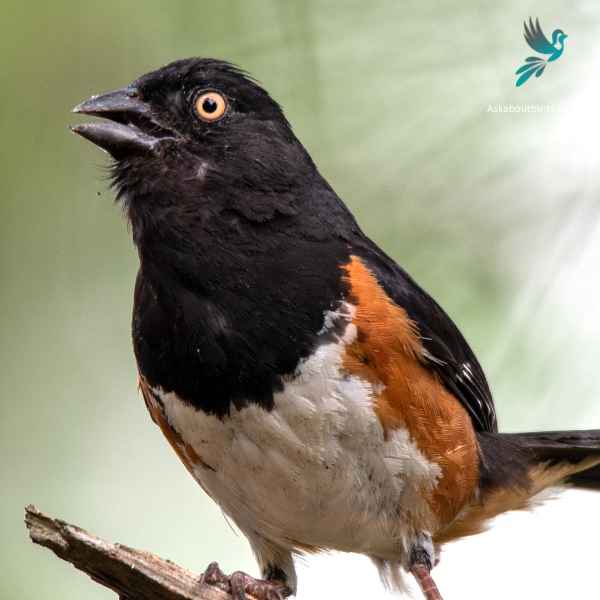
| Feature | Measurement |
|---|---|
| Scientific Name | Pipilo erythrophthalmus |
| Length | 6.8 to 9.1 in |
| Wingspan | 7.9–11.8 in |
| Weight | 32 to 53 g |
The Eastern Towhee is a distinctive songbird known for its unique calls and eye-catching coloration.
Appearance: Male Eastern Towhees are characterized by a striking combination of a black head, back and tail, contrasting with a white belly and rufous flanks. Females sport similar patterns but instead of black, they have a rich brown color. Both genders have red eyes, lending a special charm to their overall appearance.
Diet: Eastern Towhees primarily feed on a variety of insects, seeds, and berries. Their diet is quite diverse, taking advantage of seasonal offerings, which includes beetles, caterpillars, spiders, acorns, grass seeds, and various fruits and berries.
Reproduction: Eastern Towhees build their nests on or near the ground, often in a shrub or a small tree. The female lays around 3-5 eggs and takes the primary role in incubating them over about 12-13 days.
Orchard Oriole
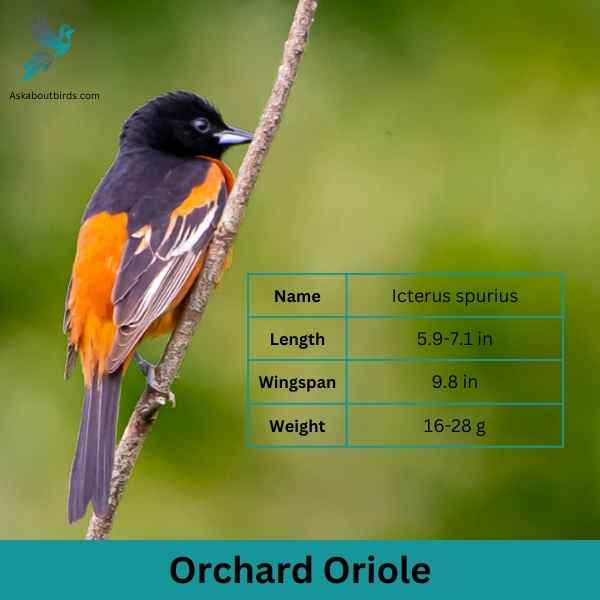
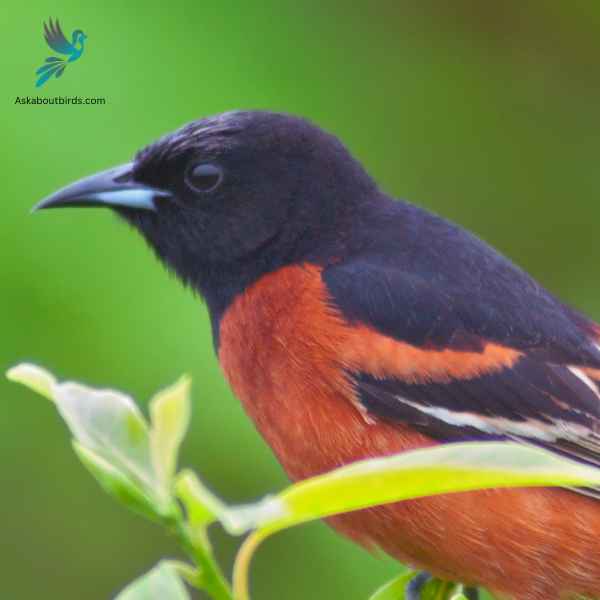
| Feature | Measurement |
|---|---|
| Scientific Name | Icterus spurius |
| Length | 5.9-7.1 in |
| Wingspan | 9.8 in |
| Weight | 16-28 g |
The Orchard Oriole is a small songbird noted for its distinctive coloration and melodic song.
Appearance: Male Orchard Orioles are a striking sight with their dark chestnut body and black head and black and white wings, while females and immature males are olive-green and feature a yellowish underpart. The species is often recognized by its slender body and pointed bill.
Diet: The diet of the Orchard Oriole consists primarily of insects, fruits, and nectar. They are adept at catching insects mid-air and are also known to sip nectar from flowers, aiding in pollination. When fruits are in season, they make up a substantial portion of the bird’s diet.
Reproduction: Orchard Orioles often nest in open woodlands and orchards, hence their name. The female is responsible for building the nest, typically choosing a location in a tree or shrub. The female lays a clutch of 4 to 6 eggs, which she incubates for about two weeks.
Blackburnian Warbler
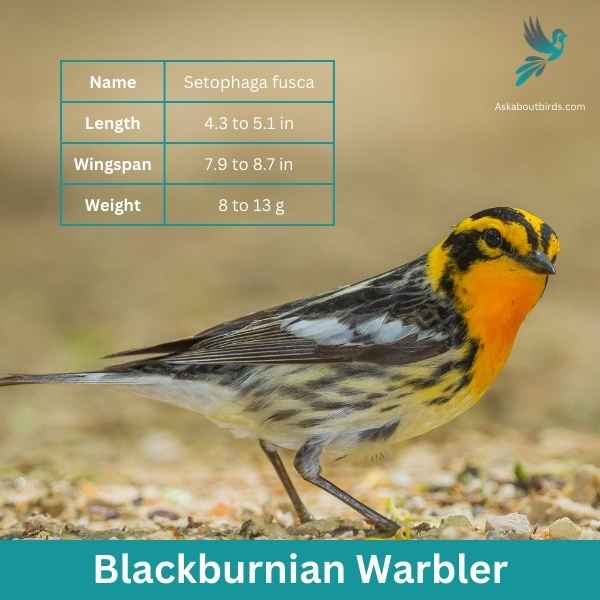

| Feature | Measurement |
|---|---|
| Scientific Name | Setophaga fusca |
| Length | 4.3 to 5.1 in |
| Wingspan | 7.9 to 8.7 in |
| Weight | 8 to 13 g |
The Blackburnian Warbler is a strikingly colored songbird that captivates observers with its vivid plumage, especially during the breeding season. Often found flitting high in the treetops of North American forests, its melodious song is as enchanting as its appearance.
Appearance: Male Blackburnian Warblers are distinguished by their fiery-orange throats, contrasting sharply with a black face, crown, and streaked back. They also have white underparts with black streaks on the sides. Females have a more muted coloration, with a yellowish or pale orange throat and less pronounced streaking.
Diet: Blackburnian Warblers primarily feed on insects and spiders. They are adept at foraging in the canopy, where they glean insects from the surface of leaves and branches or catch them mid-air in quick, agile flights.
Reproduction: Blackburnian Warblers build their nests high up in coniferous trees, often on horizontal branches. The nest is a neat cup made of twigs, grass, and moss, lined with softer materials like hair or feathers. The female lays a clutch of 4 to 5 eggs and takes the lead in incubation.
Where to Spot Virginia’s Orange Birds
The verdant terrains of Virginia are a birdwatcher’s paradise, brimming with spots that offer glimpses into the vibrant world of avian wonders. Here are some of the standout locations in the Old Dominion for bird enthusiasts, especially those on the lookout for the vivid orange-tinted species:
- Chincoteague National Wildlife Refuge: Located on the Virginia side of Assateague Island, this refuge is renowned for its migratory birds and wild ponies. The wetlands here act as a magnet for shorebirds, waterfowl, and, of course, several orange-hued species.
- Shenandoah National Park: Nestled within the Blue Ridge Mountains, this park offers over 200 species of birds. Its varied elevations and habitats are perfect for spotting warblers, orioles, and other vibrantly colored birds.
- Great Dismal Swamp National Wildlife Refuge: Spanning over 112,000 acres, this refuge is a haven for over 200 bird species. Its dense forests and wetlands make it an ideal spot for spotting a diverse range of birds, including several with bright orange plumage.
- Back Bay National Wildlife Refuge: Located in southeastern Virginia, this refuge is a mix of barrier islands, dunes, and freshwater marshes. It’s a prime location for migratory birds, ensuring a plethora of sightings, particularly in the spring and fall.
- Highland County: Known as “Virginia’s Switzerland,” this region is renowned for its hawk watches. Its high elevations offer breathtaking views and the chance to spot raptors, warblers, and more against the backdrop of the scenic Appalachian Mountains.
| State’s Orange Birds | Best Spots for Orange Birds |
|---|---|
| Maryland’s Orange Birds | 1. Blackwater National Wildlife Refuge 2. Assateague Island National Seashore 3. Patuxent Research Refuge |
| West Virginia’s Orange Birds | 1. Canaan Valley National Wildlife Refuge 2. New River Gorge National Park and Preserve 3. Cranberry Glades Botanical Area |
| Kentucky’s Orange Birds | 1. Land Between the Lakes National Recreation Area 2. Daniel Boone National Forest 3. Red River Gorge Geological Area |
| Tennessee’s Orange Birds | 1. Great Smoky Mountains National Park 2. Radnor Lake State Park 3. Reelfoot Lake State Park |
| North Carolina’s Orange Birds | 1. Alligator River National Wildlife Refuge 2. Cape Hatteras National Seashore 3. Pisgah National Forest |
FAQs on Orange Bird Species Found in Virginia
What orange-breasted birds are common in Virginia’s forests?
In Virginia, the American Robin is a prominent bird with an orange breast. They are medium-sized birds that can be spotted foraging on the forest edges and in deciduous forests, often looking for small insects in the leaf litter. Another bird with hints of orange is the Eastern Bluebird, often seen in areas with isolated trees, showcasing its bright yellow-green hue combined with an orange breast.
Which birds with bright orange throats can be found in Virginia?
The Ruby-throated Hummingbird, known for its brilliant bright orange throats in breeding males, is a frequent visitor to Virginia during the warmer months. They are particularly attracted to hummingbird feeders filled with sugar water and can also be seen hovering around flowers, extracting nectar. These birds predominantly inhabit woodland edges and prefer regions with deciduous and coniferous forests.
Are there any birds with rusty orange plumage spotted in Virginia?
Yes, in Virginia, the Hooded Oriole can be seen, especially in the western half of the state. The breeding males are especially striking, with their rusty orange bodies and black heads. They are often found in pine forests and are attracted to feeders stocked with grape jelly and nectar.
Which year-round residents in Virginia have orange features?
The American Robin, with its orange breast and dark brown back, is a year-round resident of Virginia. They’re commonly seen across both urban and woodland edges. Additionally, the Red-shouldered Hawk, a raptor with reddish-brown plumage and red-orange sides, is also a year-round inhabitant of Virginia, often perching high in coniferous and deciduous forests, surveying for prey.

